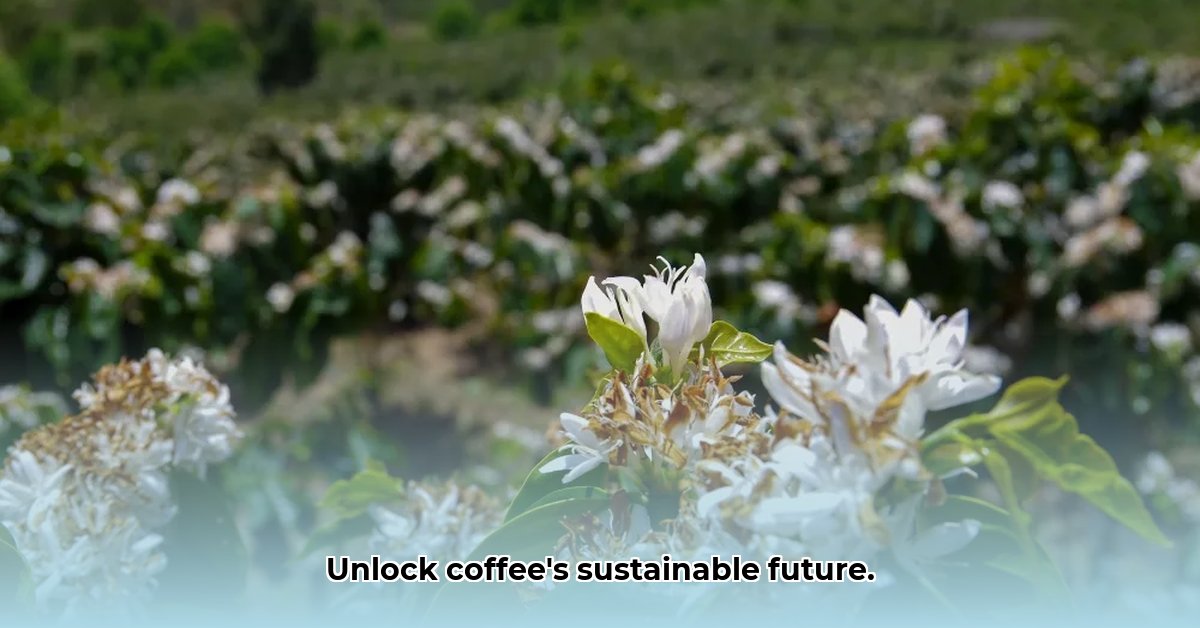Coffee production faces significant challenges from shifting weather patterns and pests that threaten the delicate coffee flower, the very origin of our beloved daily brew. Learn more about the vital role pollinators play in coffee production: pollinator importance. This comprehensive guide explores the nuances of arabica and robusta varieties, pinpointing their vulnerabilities and outlining actionable strategies for achieving sustainable harvests. Whether you’re a seasoned farmer, an avid coffee enthusiast, or simply someone who cares about ethical sourcing, this roadmap will illuminate the path towards a more resilient and ethically-sourced coffee industry.
The Coffee Flower: Securing the Future of Our Favorite Brew
The coffee flower, with its intoxicating fragrance and promise of a rich, flavorful cup, is increasingly vulnerable to the impacts of climate change. This vulnerability directly affects both the quality and quantity of coffee beans produced, posing a significant threat to the livelihoods of millions of farmers who rely on coffee as their primary source of income. Prioritizing coffee flower sustainability is no longer an option; it’s an imperative.
The health and vitality of the coffee flower directly influence the quality of the beans that eventually find their way into our mugs. Climate change, characterized by unpredictable rainfall patterns and fluctuating temperatures, places immense stress on coffee flowers. This stress can lead to reduced flowering, weaker bean development, and an overall decline in crop yields – a domino effect with far-reaching and devastating consequences for the entire coffee industry. So, how do we effectively navigate these critical coffee flower vulnerabilities?
Consider these intertwined challenges that demand immediate attention:
- Climate Change-Induced Chaos: Increasingly unpredictable weather patterns are disrupting traditional flowering cycles, leading to inconsistent and unreliable coffee production.
- Escalating Pest and Disease Pressures: Unstable weather conditions weaken coffee plants, making them significantly more susceptible to infestation by pests and outbreaks of debilitating diseases.
- Limitations of Traditional Farming Practices: Conventional farming methods are often ill-equipped to cope with the rapidly evolving realities of a changing climate, leading to decreased productivity and increased environmental impact.
However, amidst these challenges, promising and innovative strategies are emerging that hold the potential to help coffee flowers not only survive but thrive, ultimately securing the long-term future of coffee production. How can farmers proactively adapt to these profound environmental changes and effectively safeguard their precious harvests?
1. Precision Irrigation: A Smarter Approach to Water Management: Implement precision irrigation systems that deliver targeted watering precisely where and when it’s needed, minimizing water waste and maximizing the benefits to coffee plants, particularly during prolonged dry spells. Coupled with responsible soil management practices, optimized water usage holds the key to enhanced crop resilience and improved flower development.
2. Integrated Pest Management (IPM): A Sustainable and Holistic Approach to Pest Control: Embrace integrated pest management (IPM) strategies that combine a variety of techniques, including the introduction of natural predators, the strategic use of biopesticides, and the promotion of on-farm biodiversity. By minimizing reliance on synthetic pesticides, IPM protects the environment and promotes healthier, more resilient coffee plants.
3. Breeding for a Bolder Future: Developing Climate-Resilient Coffee Varieties: Invest in scientific research and development aimed at breeding climate-resilient coffee varieties that exhibit enhanced tolerance to heat, drought, and common coffee diseases. Through advanced plant breeding techniques and, where appropriate, genetic modification, scientists can create coffee plants that are better equipped to withstand the challenges of a changing climate.
4. Unlocking the Flower’s Potential: Finding New Value in Coffee Flower Byproducts: Explore opportunities to generate additional income streams by utilizing coffee flowers to produce value-added products such as coffee flower tea, natural cosmetics, and even specialty food ingredients. Diversifying revenue streams not only enhances the economic resilience of coffee farmers but also reduces waste and promotes a more circular economy.
Let’s examine stakeholder collaboration.
| Stakeholder | Short-Term Actions | Long-Term Actions |
|---|---|---|
| Farmers | Implement improved irrigation techniques, adopt IPM strategies, meticulously monitor soil health. | Invest in climate-resilient coffee plant varieties, proactively explore precision agriculture technologies, strategically diversify income streams to mitigate risk. |
| Coffee Companies | Prioritize sourcing sustainably grown coffee beans, actively support farmer training programs and community initiatives. | Invest in cutting-edge research and development of climate-resilient coffee varieties, promote transparent and equitable supply chains, advocate for responsible environmental practices. |
| Governments/NGOs | Allocate funding for research into climate-resilient coffee solutions, generously provide farmer training programs and financial incentives. | Develop comprehensive national climate adaptation strategies specifically tailored for coffee production, foster international collaboration on coffee sustainability initiatives. |
The long-term future of coffee depends on the survival and flourishing of the coffee flower. Farmers, coffee companies, governments, non-governmental organizations, and consumers alike must work collaboratively, embracing sustainable practices, investing in innovative research, and fostering a shared commitment to a thriving and environmentally responsible coffee industry. What crucial role can each of us play to ensure the longevity and sustainability of our beloved coffee for generations to come?
How to Improve Coffee Plant Flowering Consistency in Changing Climates
Key Takeaways:
- Climate change poses a significant threat to sustainable coffee production, negatively impacting flowering patterns and overall crop yield.
- The implementation of regenerative agriculture practices is crucial for achieving long-term sustainability and enhancing the resilience of coffee plants.
- Strategic diversification of farming systems improves resilience to environmental and economic shocks, providing a vital safety net for coffee farmers.
- The development and adoption of climate-resilient coffee varieties are essential for adapting to future climate conditions.
- Effective collaboration among stakeholders is key to securing a sustainable and prosperous coffee future for the coffee industry.
Understanding the Challenges
Climate change is profoundly disrupting coffee flowering cycles, resulting in lower yields, diminished bean quality, and jeopardizing the livelihoods of countless farmers who depend on coffee production for their survival. It is imperative that we collectively emphasize the adoption of regenerative agriculture practices for coffee plants to restore ecosystem health. Subtle, yet profound, changes in temperature and rainfall patterns are disrupting the delicate balance of coffee flowering, leading to decreased profitability.
Regenerative Practices: The Foundation of Resilience
Regenerative agriculture is a holistic approach to farming that prioritizes the restoration of soil health, the enhancement of biodiversity, and the overall improvement of ecosystem function. Stumping, the practice of cutting back mature coffee plants to stimulate new growth, is a particularly important regenerative technique. While proper stumping techniques are vital for successful regrowth, the optimal frequency of stumping depends on a number of factors, including soil fertility, available resources, and climate conditions. How can the strategic implementation of regenerative practices restore coffee plant resilience, improve flowering consistency, and foster long-term sustainability?
Diversification: Spreading the Risk, Enhancing Resilience
Intercropping, the practice of growing other crops alongside coffee plants, is a powerful diversification strategy that improves soil fertility, provides valuable shade, suppresses weed growth, and enhances overall farm resilience. By reducing reliance on a single crop, intercropping provides a vital safety net against fluctuating weather patterns, volatile market prices, and outbreaks of pests and diseases. Is intercropping the safety net that coffee farmers need to weather the storms of a changing climate?
Climate-Resilient Coffee Varieties: Tomorrow’s Beans, Today’s Investment
Scientists are actively engaged in the development of climate-resilient coffee varieties that exhibit enhanced resistance to higher temperatures, prolonged drought, and increasingly extreme weather events. Strategic investment in the research, development, and widespread adoption of these climate-resilient varieties is essential for securing the long-term future of coffee production and ensuring the availability of climate-resilient coffee plant varieties for generations to come.
Practical Steps for Farmers
For smallholder farmers, a combination of the following approaches is essential for ensuring sustainable coffee production:
- Optimize Stumping Techniques: Maximize regrowth rates while minimizing plant stress through careful stumping practices tailored to local conditions.
- Embrace Intercropping Systems: Experiment with different intercropping systems to identify the best fit for your specific farm, climate, and market conditions.
- Improve Pest and Disease Management: Invest in proactive pest and disease management strategies that minimize reliance on synthetic chemicals and promote a healthy ecosystem.
- Explore Climate-Resilient Varieties: Transition to climate-resilient coffee varieties as they become available, carefully evaluating their performance in your local environment.
The Path Forward: Collaboration is Key
Addressing the critical question of how to improve coffee plant flowering consistency in changing climates requires a collaborative and coordinated effort among all stakeholders in the coffee industry. Researchers must continue to develop climate-resilient varieties and improved farming practices. Governments and non-governmental organizations must provide training, financial assistance, and policy support to enable farmers to adopt sustainable practices. Coffee companies must prioritize sourcing ethically produced coffee and actively support sustainable farming initiatives. Can farmers and coffee companies work together in a mutually beneficial partnership to ensure consistent flowering, high-quality yields, and a sustainable future for the coffee industry?
Sustainable Coffee Flower Processing for Value-Added Products
Key Takeaways:
- Coffee flowers, often treated as agricultural waste, hold significant untapped potential for creating a wide range of valuable and innovative products.
- The adoption of Sustainable Coffee Flower Processing for Value-Added Products offers a compelling combination of economic and environmental benefits, creating a win-win scenario for farmers, processors, and consumers alike.
- The utilization of green extraction methods, such as supercritical fluid extraction and enzyme-assisted extraction, is essential for unlocking the full potential of coffee flowers and preserving their delicate bioactive compounds.
- Effective collaboration across the entire coffee supply chain, from farmers to processors to
















